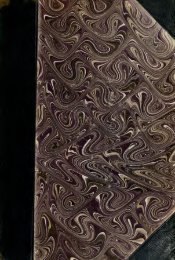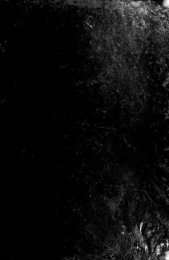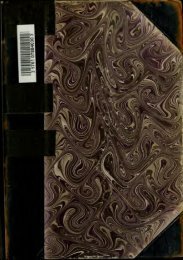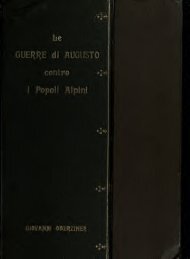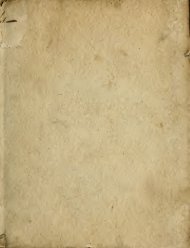Figurative uses of animal names in Latin and their ... - mura di tutti
Figurative uses of animal names in Latin and their ... - mura di tutti
Figurative uses of animal names in Latin and their ... - mura di tutti
Create successful ePaper yourself
Turn your PDF publications into a flip-book with our unique Google optimized e-Paper software.
S3<br />
In spite <strong>of</strong> the statement <strong>of</strong> Varro^^e <strong>and</strong> Pl<strong>in</strong>y,^*'' cunicuius,<br />
' an underground passage,' is derived from the name<br />
<strong>of</strong> an <strong>animal</strong> <strong>and</strong> not vice versa.<br />
Paulus gives the real sequence <strong>of</strong> the transfer <strong>in</strong> the<br />
first <strong>of</strong> his explanations, though the second is an etymolog-<br />
ical absur<strong>di</strong>ty : Cuniculum, id est foramen sub terra occul-<br />
tum, aut ab <strong>animal</strong>i, quod simile est lepori, appellatur, cui<br />
subterfossa terra latere est solitum, aut a cuneorum simili-<br />
tud<strong>in</strong>e qui omnem materiam <strong>in</strong>trant fidentes.^**<br />
Vegetius, however, <strong>di</strong>splays no hesitancy <strong>in</strong> his deriva-<br />
tion, rightly ascrib<strong>in</strong>g the transfer to the <strong>animal</strong>'s habit <strong>of</strong><br />
burrow<strong>in</strong>g: Genus oppugnationum est subterraneum atque<br />
secretum, quod cuniculum vocant a leporibus, qui cavernas<br />
sub terris fo<strong>di</strong>unt ibique conduntur.<br />
While the burrow<strong>in</strong>g ca<strong>uses</strong> the transfer, an <strong>in</strong>terme<strong>di</strong>ate<br />
step must have been the application <strong>of</strong> the term cuniculus to<br />
the results <strong>of</strong> the <strong>animal</strong>'s excavat<strong>in</strong>g propensities, i. e. to<br />
the burrow.<br />
A figure somewhat similar to that <strong>in</strong> cuniculus is found<br />
<strong>in</strong> talpa, the mole, or <strong>di</strong>gger: Talpa. Mach<strong>in</strong>a ad sufFo-<br />
<strong>di</strong>endos muros, sub qua latent, qui cuniculos conficiunt.^*"<br />
The cunicularii <strong>of</strong> earlier days are recalled by the tal-<br />
parii: Habebat quippe quosdam artifices, quos Fossores vel<br />
Talparios vocant, qui ad modum talpae subterranea fo<strong>di</strong>-<br />
entes, quaslibet murorum et turrium firmitates ferramentis<br />
vali<strong>di</strong>ssimis perrumpebant.^*^<br />
The popular belief <strong>in</strong> the burrow<strong>in</strong>g ability <strong>of</strong> the rabbit<br />
is shown by Pl<strong>in</strong>y's statement, on Varro's authority, that the<br />
cuniculi underm<strong>in</strong>ed a town <strong>in</strong> Spa<strong>in</strong>.^*^ M. Varro auctor<br />
est a cuniculis suffosum <strong>in</strong> Hispania oppidum.<br />
Martial has a clever <strong>di</strong>stich play<strong>in</strong>g upon the two <strong>uses</strong><br />
<strong>of</strong> the word cuniculus:<br />
Gaudet <strong>in</strong> effossis habitare cuniculus antris.<br />
Monstravit tacitas hostibus ille vias.^*^<br />
Varro Rust, iii, 12, 6.<br />
^'Pl<strong>in</strong>. Nat. viii, 55. 81, (218)- Veg. iv, 24.<br />
"^Du Cange, s. v. Talpa.<br />
"^ Quoted by Du Cange, s. v. Talparii.<br />
'"Pl<strong>in</strong>. Nat. viii, 29, 43, (104).<br />
""Mart, xiii, 60.<br />
"' Paul. Fest. p. 50 Mull.


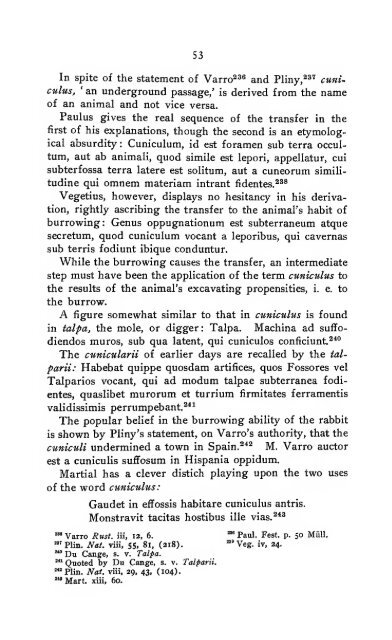
![Das Kriegswesen der Alten [microform] - mura di tutti](https://img.yumpu.com/21606999/1/167x260/das-kriegswesen-der-alten-microform-mura-di-tutti.jpg?quality=85)


